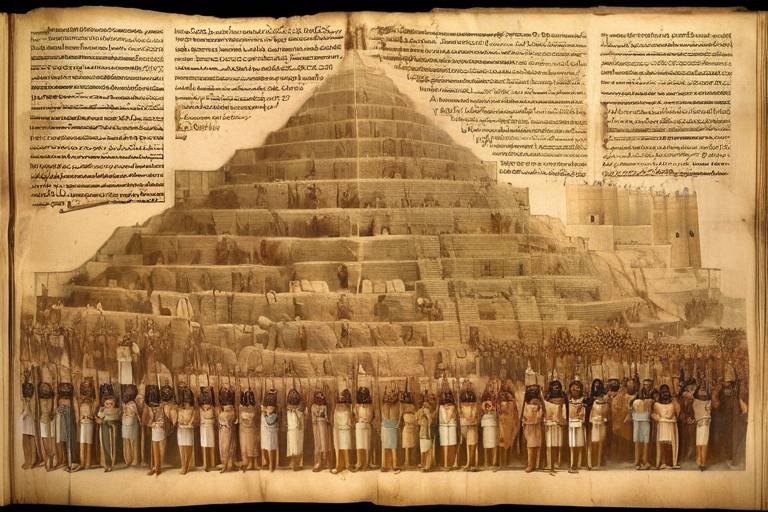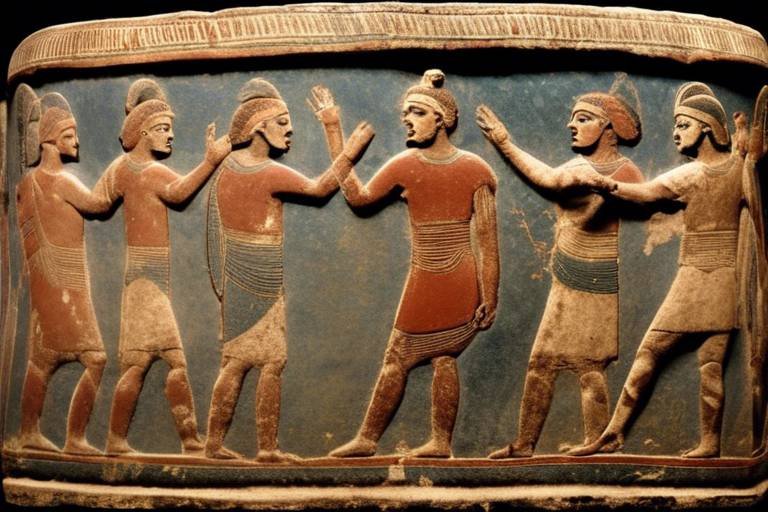The Rise and Fall of the Babylonian Empire - Historical Insights
The Babylonian Empire, with its rich history and intricate rise to power, stands as a testament to the complexities of ancient civilizations. From its humble beginnings as a collection of city-states to its zenith under Hammurabi's rule, the empire's journey is a tale of ambition, conquest, and eventual decline.
At the heart of the Babylonian Empire's ascendancy lay a series of strategic conquests and alliances that solidified its dominance in the ancient Near East. Through military prowess and diplomatic finesse, Babylon rose to prominence, establishing itself as a formidable force in the region.
However, like all great empires, Babylon too faced internal strife and external pressures that eventually led to its downfall. The once-mighty empire crumbled under the weight of administrative challenges, invasions, and a shifting geopolitical landscape, marking the end of an era.
Despite its eventual decline, the Babylonian Empire left a lasting legacy on the world stage. Its contributions to mathematics, astronomy, and cultural practices reverberate through the annals of history, shaping the development of subsequent civilizations in profound ways.
As we unravel the historical insights behind the rise and fall of the Babylonian Empire, we are reminded of the cyclical nature of power and the enduring lessons that can be gleaned from ancient civilizations. The echoes of Babylon's triumphs and tribulations resonate in contemporary geopolitical dynamics, offering valuable insights into governance, diplomacy, and the fragility of empires.

Origins of the Babylonian Empire
The origins of the Babylonian Empire can be traced back to the ancient city-states of Mesopotamia, where a rich tapestry of cultures and civilizations flourished. Among these city-states, Babylon emerged as a prominent power, gradually asserting its dominance over the region through strategic alliances and military conquests. The early history of Babylon is shrouded in myth and legend, with tales of gods and heroes shaping the destiny of the city.
One of the pivotal moments in the formation of the Babylonian Empire was the reign of Hammurabi, the sixth king of the First Babylonian Dynasty. Hammurabi's ascension to the throne marked a period of consolidation and expansion for Babylon, as he sought to unify the disparate city-states under his rule. His most enduring legacy, Hammurabi's Code, stands as a testament to his vision of a just and orderly society.
Under Hammurabi's leadership, Babylon experienced a cultural renaissance, with advancements in literature, art, and architecture. The city's ziggurats and temples became symbols of its prosperity and power, attracting pilgrims and traders from far and wide. The Hanging Gardens of Babylon, one of the Seven Wonders of the Ancient World, epitomized the empire's engineering prowess and aesthetic sophistication.
As Babylon grew in wealth and influence, its borders expanded through a series of military campaigns and diplomatic maneuvers. The Babylonian army, renowned for its discipline and organization, conquered neighboring territories and established a vast empire that stretched from the Persian Gulf to the Mediterranean Sea. The wealth brought in by these conquests fueled further growth and development within the empire.
However, the seeds of Babylon's eventual decline were sown within its own borders. Internal power struggles, corruption, and administrative inefficiencies weakened the empire from within, while external threats loomed on the horizon. Invasions by foreign powers, such as the Assyrians and the Persians, further eroded Babylon's strength, leading to its eventual downfall.
Despite its ultimate demise, the Babylonian Empire left a lasting legacy that reverberated throughout the ancient world and beyond. Its contributions to mathematics, astronomy, and literature laid the foundation for future civilizations to build upon. The cultural and religious practices of Babylon influenced the development of subsequent societies, leaving an indelible mark on the tapestry of human history.
In modern times, the rediscovery of Babylon through archaeological excavations has offered new insights into the empire's past glory. Efforts to preserve and showcase the historical significance of the ancient city continue to captivate scholars and enthusiasts alike, shedding light on a bygone era of splendor and grandeur.
Reflecting on the rise and fall of the Babylonian Empire, we are reminded of the impermanence of power and the cyclical nature of history. The lessons gleaned from Babylon's story serve as a cautionary tale for contemporary societies, urging us to strive for justice, wisdom, and unity in the face of adversity and challenges.

Hammurabi's Code and Legal System
Hammurabi's Code, a set of laws established by the Babylonian king Hammurabi, stands as one of the earliest known legal systems in human history. This code, inscribed on a stele, encompassed a wide range of legal matters, from criminal justice to commercial transactions, aiming to provide justice and maintain order in Babylonian society.
One of the remarkable aspects of Hammurabi's Code was its principle of "an eye for an eye," reflecting the concept of retributive justice. This principle ensured that punishments were proportional to the crimes committed, emphasizing fairness and deterrence in the legal system. Additionally, the code included regulations on property rights, marriage, and inheritance, outlining the rights and responsibilities of individuals within the society.
Moreover, Hammurabi's Code introduced the idea of presumption of innocence, requiring accusers to provide evidence to support their claims. This shift towards evidence-based justice marked a significant advancement in legal thinking during that era, setting a precedent for future legal systems.
Furthermore, the legal system under Hammurabi's reign was characterized by a hierarchical structure, with different punishments based on the social status of individuals. This stratified approach to justice aimed to maintain social order and uphold the authority of the ruling elite, reflecting the power dynamics prevalent in ancient Babylonian society.
In addition to its regulatory function, Hammurabi's Code also served as a tool for governance and administration, ensuring uniformity and predictability in legal decisions. The code was prominently displayed in public spaces, symbolizing the king's commitment to justice and the rule of law, thereby enhancing the legitimacy of the Babylonian monarchy.
Overall, Hammurabi's Code and the legal system of the Babylonian Empire played a crucial role in shaping the societal norms and legal principles of the ancient world. The legacy of this legal framework transcended time, influencing subsequent legal systems and serving as a testament to the enduring impact of Babylonian civilization.

Architectural Marvels of Babylon
The architectural marvels of Babylon stand as a testament to the ingenuity and grandeur of the ancient empire. Among the most renowned structures was the legendary Hanging Gardens, considered one of the Seven Wonders of the Ancient World. These lush terraced gardens, built by King Nebuchadnezzar II, were a stunning display of engineering prowess, featuring an intricate irrigation system that allowed for the cultivation of a variety of plants and trees in a desert environment.
Aside from the Hanging Gardens, Babylon boasted impressive temples and palaces that showcased the empire's architectural sophistication. The Ishtar Gate, adorned with vibrant glazed bricks depicting mythical creatures, served as a grand entrance to the city and symbolized Babylon's wealth and power. The city's ziggurat, a massive stepped pyramid dedicated to the god Marduk, dominated the skyline and served as a focal point for religious ceremonies and rituals.
Furthermore, Babylon's defensive walls were a formidable feat of engineering, with the inner wall reportedly wide enough for chariots to race along its peak. These walls not only provided protection for the city but also served as a symbol of Babylonian strength and resilience against external threats.

Conquests and Expansion
The conquests and expansion of the Babylonian Empire were pivotal in establishing its dominance in the ancient Near East. Under the reign of powerful rulers such as Hammurabi, the empire embarked on ambitious military campaigns that shaped its territorial growth and influence. Through strategic alliances, military prowess, and diplomatic maneuvers, Babylon extended its reach across Mesopotamia, asserting control over key trade routes and resources.
One of the most notable conquests of the Babylonian Empire was the capture of the city of Mari, a significant trading center along the Euphrates River. This conquest not only expanded Babylon's territorial holdings but also solidified its economic power in the region, enabling the empire to amass wealth and resources that fueled further expansion.
Furthermore, Babylon's military campaigns were characterized by innovative warfare tactics and siege techniques. The empire's army, equipped with advanced weaponry such as chariots and bronze weapons, demonstrated superior military capabilities that allowed for successful conquests of rival city-states and kingdoms.
Through a combination of military might, strategic alliances, and administrative efficiency, the Babylonian Empire established itself as a formidable force in the ancient world. The conquests and expansion of the empire not only increased its territorial holdings but also enhanced its cultural influence, as conquered territories adopted Babylonian customs, language, and governance structures.

Decline of the Babylonian Empire
As the Babylonian Empire reached its zenith of power and influence, internal strife and external pressures began to sow the seeds of its eventual decline. The once mighty empire, known for its formidable military prowess and rich cultural heritage, started to falter under the weight of administrative challenges and political instability.
One of the primary factors contributing to the decline of the Babylonian Empire was the succession of weak rulers who struggled to maintain the empire's territorial integrity and unity. In-fighting among the ruling elite further weakened the central authority, leading to a fragmentation of power and a loss of control over the empire's vast territories.
External invasions also played a significant role in the downfall of the Babylonian Empire. The incursions of foreign powers, such as the Assyrians and later the Persians, posed serious threats to Babylon's security and stability. These invasions not only drained the empire's resources but also eroded its military capabilities, making it increasingly vulnerable to external aggression.
Moreover, administrative challenges and economic woes plagued the empire during its later years. Corruption, inefficiency, and mismanagement hindered the effective governance of Babylonian territories, leading to widespread discontent among the populace. The once prosperous empire began to suffer from economic decline and social unrest, further weakening its foundations.
As internal discord and external pressures mounted, the Babylonian Empire gradually lost its grip on power and influence in the ancient Near East. The once mighty civilization, which had stood as a beacon of culture and sophistication, eventually succumbed to the tides of history, marking the end of an era.

Legacy of the Babylonian Empire
The legacy of the Babylonian Empire is a rich tapestry woven into the fabric of ancient history, leaving an indelible mark on the civilizations that followed. One of the most significant contributions of the Babylonians was in the field of mathematics, where they developed advanced mathematical techniques including the concept of zero and the base-60 numeral system. These innovations laid the groundwork for future mathematical advancements and influenced the mathematical systems of later cultures.
Furthermore, the Babylonians made notable strides in astronomy, creating the first known astronomical almanac and accurately predicting celestial events such as lunar eclipses. Their observations of the stars and planets served as the foundation for later astronomical studies and were instrumental in shaping our understanding of the cosmos.
Religiously, the Babylonian Empire's pantheon of gods and religious practices had a lasting impact on the region. The Babylonians worshipped a diverse array of deities, each associated with different aspects of life and nature. Their religious beliefs and rituals influenced the development of religious practices in Mesopotamia and beyond, shaping the spiritual landscape of the ancient world.
Culturally, the Babylonians were renowned for their architectural achievements, most notably the Hanging Gardens of Babylon, which were considered one of the Seven Wonders of the Ancient World. These lush gardens, built on terraced platforms with cascading greenery and exotic plants, showcased the empire's engineering prowess and aesthetic sensibilities, leaving a lasting impression on architectural design.
Moreover, the Babylonian Empire's legacy extended to its legal system, particularly through Hammurabi's Code, one of the earliest known sets of laws in human history. This code established principles of justice and fairness, emphasizing the concept of an eye for an eye and equal punishment for equal crimes. The influence of Hammurabi's Code can be seen in later legal systems, shaping the development of jurisprudence worldwide.

Rediscovery of Babylon in Modern Times
Throughout history, the ancient city of Babylon has captivated the imagination of scholars, archaeologists, and history enthusiasts alike. However, it wasn't until modern times that efforts to rediscover and unearth the remnants of this once-great empire gained momentum. The has been a fascinating journey that sheds light on the rich history and cultural heritage of this legendary city.
Archaeological excavations in the 19th and 20th centuries unearthed a treasure trove of artifacts and structures that provided valuable insights into the daily life, architecture, and governance of ancient Babylon. The meticulous work of archaeologists and historians has helped piece together the puzzle of this enigmatic civilization, allowing us to glimpse into the past and appreciate the grandeur of Babylon.
One of the most notable discoveries in modern times was the famed Hanging Gardens of Babylon, one of the Seven Wonders of the Ancient World. While the exact location and existence of the gardens remain a topic of debate among scholars, the allure of this architectural marvel continues to capture the imagination of people worldwide.
Efforts to preserve and protect the archaeological sites of Babylon have been ongoing, with organizations and governments working together to ensure the conservation of this invaluable heritage. Museums and cultural institutions around the world showcase artifacts from Babylon, allowing visitors to connect with the legacy of this ancient empire.
The serves as a poignant reminder of the enduring legacy of ancient civilizations and the importance of preserving our shared heritage for future generations. As we continue to unravel the mysteries of Babylon, we gain a deeper appreciation for the achievements and innovations of this remarkable civilization.

Lessons from Babylonian History
When delving into the annals of Babylonian history, one cannot help but uncover a treasure trove of invaluable lessons that resonate through the corridors of time. The rise and fall of the Babylonian Empire serve as a poignant reminder of the ephemeral nature of power and the enduring impact of governance on the trajectory of civilizations.
One of the paramount lessons gleaned from Babylonian history is the importance of effective leadership and governance. The reign of Hammurabi exemplifies the significance of establishing a robust legal system and fostering societal cohesion through equitable laws and regulations. Hammurabi's Code, with its emphasis on justice and fairness, underscores the pivotal role of governance in maintaining social order and stability.
Furthermore, the Babylonian Empire's interactions with neighboring states illuminate the complexities of diplomacy and foreign relations. The empire's conquests and alliances underscore the strategic imperatives of balancing military might with diplomatic finesse. The art of negotiation and statecraft, as evidenced in Babylon's dealings with rival powers, offers timeless insights into the dynamics of international relations.
Moreover, the decline of the Babylonian Empire serves as a cautionary tale about the perils of complacency and internal discord. The erosion of central authority, coupled with administrative inefficiencies, paved the way for external incursions and ultimately led to the empire's demise. The lesson here is clear: vigilance, adaptability, and effective governance are essential pillars for the longevity of any political entity.
Additionally, the legacy of the Babylonian Empire in the realms of science, mathematics, and culture underscores the enduring impact of intellectual pursuits on societal progress. The empire's contributions to astronomy, mathematics, and literature continue to reverberate through the corridors of academia, highlighting the transformative power of knowledge and innovation.
In essence, the saga of the Babylonian Empire offers a tapestry of lessons that transcend the boundaries of time and geography. From the intricacies of governance to the imperatives of diplomacy and the enduring legacy of intellectual pursuits, Babylonian history serves as a rich tapestry from which contemporary societies can draw inspiration and wisdom.
Frequently Asked Questions
- What were the key factors that led to the rise of the Babylonian Empire?
The rise of the Babylonian Empire was influenced by a combination of factors, including strategic military conquests, efficient administrative systems, and cultural achievements such as the development of Hammurabi's legal code.
- What is the significance of Hammurabi's Code in Babylonian history?
Hammurabi's Code was a crucial legal document that established a set of laws and principles for Babylonian society, promoting justice, fairness, and social order. It reflected the empire's commitment to governance and the rule of law.
- How did the Babylonian Empire contribute to the fields of mathematics and astronomy?
The Babylonians made significant advancements in mathematics, particularly in the development of the base-60 numeral system and the concept of geometric measurements. They also made astronomical observations and created accurate calendars based on celestial movements.
- What were the main reasons for the decline of the Babylonian Empire?
The decline of the Babylonian Empire can be attributed to internal power struggles, external invasions by neighboring empires, and administrative challenges that weakened the empire's stability and ability to govern effectively.
- How has the legacy of the Babylonian Empire influenced subsequent civilizations?
The legacy of the Babylonian Empire can be seen in various aspects of later civilizations, including their legal systems, architectural practices, and intellectual achievements. Babylonian contributions have had a lasting impact on the development of human civilization.



















